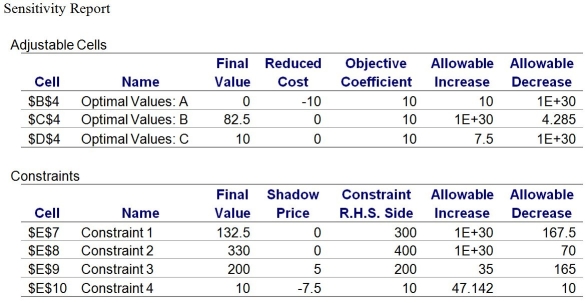Filters
Question type
A) ≤
B) ≥
C) =
D) ≠
E) ±
Correct Answer

verified
Correct Answer
verified
Question 32
True/False
The Sensitivity Report typically analyses the impact of simultaneous changes in the objective function coefficients and right-hand side constraint values on the optimal solution.
Correct Answer

verified
Correct Answer
verified
Question 33
Multiple Choice
Use this information,along with its associated Sensitivity Report,to answer the following questions.
A production manager wants to determine how many units of each product to produce weekly to maximize weekly profits.Production requirements for the products are shown in the following table.
Material 1 costs $7 a pound,material 2 costs $5 a pound,and labor costs $15 per hour.Product A sells for $101 a unit,product B sells for $67 a unit,and product C sells for $97.50 a unit.Each week there are 300 pounds of material 1;400 pounds of material 2;and 200 hours of labor.The output of product A should not be more than one-half of the total number of units produced.Moreover,there is a standing order of 10 units of product C each week.
 -Suppose that we force the production of one unit of product A.The new objective function value will be
-Suppose that we force the production of one unit of product A.The new objective function value will be
A) $925
B) $915
C) $935
D) $900
E) Not enough information is provided.
Correct Answer

verified
Correct Answer
verified
Question 34
Multiple Choice
Assume that the reduced cost of a decision variable is -$20 for a maximization problem.This implies that:
A) the objective function value will decrease by $20 if we do not produce any units of this product
B) the objective function value will not change if we produce an additional unit of this product
C) the objective function value will increase by $20 if we produce an additional unit of this product
D) the shadow price value will decrease by $20 if we produce an additional unit of this product
E) the objective function value will decrease by $20 if we produce an additional unit of this product
Correct Answer

verified
Correct Answer
verified
Showing 41 - 44 of 44
Related Exams